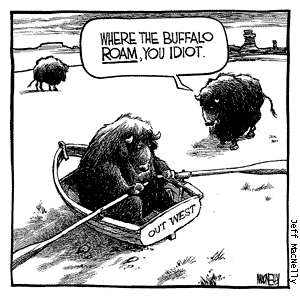Dave Barry
Cartoon by Jeff MacNellyWild West September 12, 1997
We went West for our summer vacation. Our idea was to follow in the footsteps of the hardy explorers Lewis and Clark, who traveled 8,000 miles through hostile, uncharted wilderness, a feat that was possible only because of their great courage and the fact that they left their children home. Otherwise they would have quit after maybe 200 yards.
On our trip we encountered numerous families that, after many hours together in the minivan, had reached Critical Hostility Mass. At one point we saw a family stopped at a roadside area overlooking a spectacular mountain vista, but nobody was looking at it. Two boys were slumped low in the back seat of the minivan with their baseball caps jammed down over their eyes, listening to their individual compact-disc players. A girl, maybe 12, was stomping tearfully away from the van, followed by Mom, her words echoing off the hillsides, waving some bread and shouting ``IF YOU DON'T EAT THIS SANDWICH, I'M NOT MAKING YOU ANOTHER ONE!'' A few feet away, Dad was sitting on a rock, chewing very slowly, staring at the ground. Togetherness!
On our trip, we made a painstaking effort to follow exactly the route that Lewis and Clark used, the only exception being that they took the Missouri River, whereas we took Interstate 90, which is a lot more direct and has motels. At some points the interstate is very close to the river, and you frankly have to wonder how Lewis and Clark failed to notice it. They may have been hardy, but apparently they were not the sharpest quills on the porcupine, if you get my drift.
One big advantage of the I-90 route is that it takes you to some of the amazing wonders of the West, such as the Corn Palace in downtown Mitchell, S.D. This is, I swear, one of the biggest tourist attractions in South Dakota (Official state motto: ``Gateway To North Dakota''). The Corn Palace is a large, Moorish-style building that has its exterior walls covered with an enormous mural made entirely from corn. The theme of the mural is changed every year, although you could make the argument that the true theme is always: ``We have WAY too much corn.''
But of course the biggest South Dakota tourist attraction is Mount Rushmore. You've probably seen hundreds of pictures of this famous monument, but until you are standing right in front of it, in person, you cannot truly appreciate the fact that it's only eight inches tall. There's a big lens in front of it.
No, seriously, Mount Rushmore is large and impressive, and you cannot help but feel a sense of awe as you look up at the granite-carved faces of those four great American leaders -- George Washington, Thomas Jefferson, Abraham Lincoln and Don Shula -- gazing out from the purple mountain's majesty, across the fruited plain, looking as though they are surveying the mighty nation that they helped to create and thinking: ``Since when is corn a fruit?''
Mount Rushmore is located in the Black Hills, which get their name from the fact that they are brown, gray and green. They were caused by erosion. In fact, just about all the major natural attractions you find in the West -- the Grand Canyon, the Badlands, the Goodlands, the Mediocrelands, the Rocky Mountains and Robert Redford -- were caused by erosion. Apparently at some point a huge wave of erosion swept over the West, leaving these attractions. We know this because about every 50 feet out there the National Park Service or some other agency has set up a sign that says something like POINT OF INTEREST, and when you stop to read it, it always says something like: ``The buttes you see here were created by erosion 350 million years ago during the Curvaceous Period, when the West was covered by an ocean.'' The National Park Service apparently has some kind of substance-abuse problem, because it is absolutely convinced that the West used to be covered by an ocean, although if this were true you'd think that there would be some evidence of it today in the form of, for example, a petrified boardwalk.
Some of the other natural wonders we saw on our trip were:
-- At least 500 billion fluorescent red-orange traffic cones, carefully placed on every few feet of highway across 1,000 miles and four states, alerting us that road crews were working ahead.
-- One guy (in Wyoming, I believe) who was actually working on the road.
-- A sign outside of the cow-intensive community of Dimock, S.D., that said ``SAY IT WITH CHEESE.''
But the highlight of the trip was Yellowstone National Park, which contains many amazing natural wonders that were caused by erosion and are now being preserved for future generations by a dense protective layer of buffalo poop. I personally had thought that buffalo were pretty much extinct, but it turns out that the federal government employs a large number of them in Yellowstone, where they roam around pooping while the deer and of course the antelope play, and seldom is heard a discouraging word, although you do hear a lot of people saying ``WATCH WHERE YOU STEP!'' But the buffalo really are impressive, and speaking as a taxpayer I consider them a far better deal than, for example, the Department of Commerce.
In conclusion, it was a great trip, and I want to end this account with an inspirational quote from Lewis, or possibly Clark, who said, at the end of their epic journey: ``If we write an account of this epic journey, we can deduct it on our taxes.''
zurück zum / back to
Inhalt der Dave Barry-Kolumnen / List of contents of the Dave Barry-Columns
oder / or

